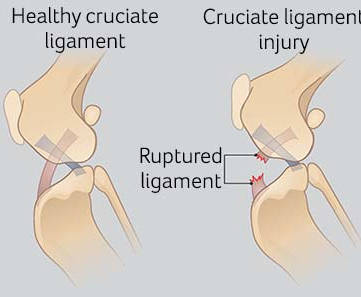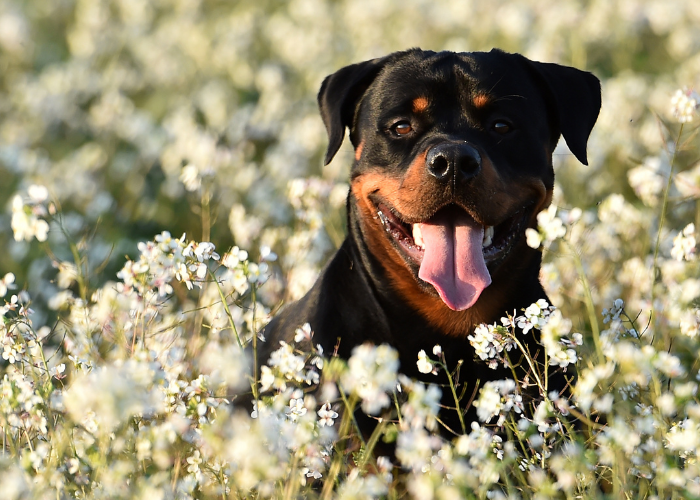Cruciate Ligament Injury In Dogs
I used to think that cruciate injury was a human problem. You know, one of those injuries responsible for benching a footballer for the season. But it’s really common in dogs too.
Even though a ligament is a ligament in structure, humans and dogs tend to injure theirs in different ways. How so? Well, in humans, cruciate damage is usually caused by sudden physical trauma, for example, as a result of a sports injury.
In dogs, disease more commonly causes cruciate injury than sudden trauma. So, this means over time diseased ligaments fray, and become ropey and weak. In these cases, even a small amount of force can rupture the ligament.
What Are These Things They Call Cruciate Ligaments?
Ligaments are incredibly, strong, fibrous tissues that connect bone to bone all over the body. They are designed to limit movement. In other words, they stabilise the movement of the bones which they connect.
Cruciate ligaments are found in the knee, or stifle, as it’s known in the dog, and they help to stabilise the stifle joint. They even have their own names. The cranial cruciate ligament (CrCL) and the caudal cruciate ligament (CaCL).
Right, let’s check those bad boys out.
In the image, you can see how these ligaments criss-cross between the bottom bone, the tibia, and the top bone, the femur. Their criss-cross structure keeps the tibia from sliding forward.
The image on the right shows a complete break or rupture of the CrCL.

Do you know damage to a ligament is called a sprain? Therefore, cruciate ligament damage is actually a sprain, and yet we throw the word sprain around like it’s no big deal. Sprains are really painful and are graded according to the level of severity of the damage they’ve suffered.
There Are 4 Grades of Sprain
I : Minimal tear
Ok, so we’ve covered what a ligament is, where the cruciate ligaments are, what they do, that they have fancy names, that in dogs a cruciate injury is thought more likely to be caused by disease, and that there are 4 grades of injury.
What does the science say about the likelihood of my dog sustaining a cruciate rupture?
Factors Contributing to Cruciate Disease
Breed Predisposition
Any breed can injure their cruciate ligament. However, cruciate disease is much more common in breeds like Labradors, Rottweilers, Boxers, West Highland White Terriers, and Newfoundlands.

Over Exercising. Exercising a dog to the point of exhaustion is not conducive to maintaining healthy joints, muscles, tissue nor is it helpful for a dog’s emotional wellbeing.
Early Neuter/Spay Research has found that early neuter/spay has a negative effect on the development of ligaments, bones, and joints.
Hormonal Imbalance Could this be connected to early neuter/spay?
My Thoughts…..
Could early neuter/spay have a bigger part to play in the disease of the cruciate ligaments than we think?
And…. If the weight and breed of our dogs are contributing factors, could cruciate injury also be a mechanical failure of the stifle joint due to the size of the breed and their leg shape?
How Do You Know Your Dog Has A Cruciate Injury?
- Sudden crying out in pain
- Lameness/hobbling
- Can’t weight bear on the affected leg
- Swelling – heat – inflammation
- Lagging behind on a walk
- Doesn’t want to straighten the leg
- Sitting with the leg sticking out to one side
The Diagnosis
Your Vet will manually test the knee for excess movement. Sometimes X-rays are also used to find the cause of pain, instability, and or lameness.
It’s Confirmed! Cruciate Injury, What Next?
Well, that depends on the grade of injury.
Your Vet will recommend the best way forward. The decision will be based on your dog’s medical history, the grade of sprain, age, weight, fitness, health, and lifestyle.
Grades I & II may be managed conservatively with anti-inflammatories, weight control, physiotherapy, clinical massage etc,.
Grades III & IV will need surgery.
The most common cruciate surgeries performed in the UK today are the tibial tuberosity advancement (TTA), and tibial plateau levelling osteotomy (TPLO).
Cruciate Injury Surgical Options

Image Credit: Fitzpatrick Referrals
Fitzpatrick Referrals website is a brilliant resource if you’d like to know more about cruciate surgery procedures and they also have helpful videos too.
What Can You Do To Limit the Risk of Sprain?
There are more factors involved in cruciate injuries in dogs than sudden trauma to the joint.
Here are 5 quick wins that you can control which will help your dog to avoid injury
1 – Don’t over-exercise your dog
2 – Keep them a healthy weight
3 – Keep the muscles around the joints mobile, supple, strong, and healthy.
4 – Cover slippy floors at home!!!
5 – Stop Ball Launching
Are You Worried About How To Help Your Dog Long Term?
I may be able to help.
I’m Angela Day and I founded Born to Run based in Suffolk.
I’m a Small Animal Rehab specialist, Canine Massage Practitioner and Core Conditioning Instructor. Core conditioning is an incredible low impact means to keep your dog fit for life and help prevent injury.
Rehabilitation and Massage treatments combined successfully release tight sore muscles, reducing pain, and improving mobility helping dogs return to full function after surgery.
If you’d like to chat about any concerns you have about your dog I’d love to hear from you. Click here to get in touch.
Angela Day, MCICM (grad), CM (Dip), MIAAT, MIRVAP (MT)


A really interesting, informative blog. I’d love to know what you consider early neutering/ spay? x
Hi Kate
Thank you for your question. I’m really glad you found the blog informative
I would consider both growth plate development and also impact on joints and soft tissues as part of the decision-making process when thinking about spay/neuter.
I hope the resources below help in both areas.
https://www.vettimes.co.uk/news/early-neutering-large-dogs-may-triple-joint-disease-risk/
A Study: Slauterbeck JR, Pankratz K, Xu KT, Bozeman SC, Hardy DM. Canine ovariohysterectomy and orchiectomy increases the prevalence of ACL injury. Clin Orthop Relat Res. 2004 Dec;(429):301-5
Thank you Angela, a really useful read!
Thank you. I’m so glad you found it helpful